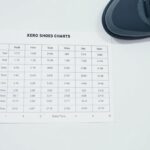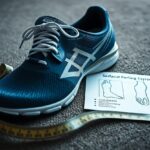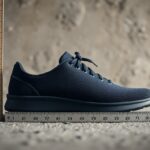Ultimate Sizing Guide for Xero Shoes: Achieve Maximum Comfort
Discover the Unique Benefits of Choosing Xero Shoes
Xero Shoes stand out as a revolutionary line of minimalist footwear designed specifically to enhance natural foot movement while maximizing your walking experience. These cutting-edge shoes feature lightweight materials and exceptional flexibility, providing a barefoot feel while ensuring necessary protection for your feet. Some of the remarkable attributes that set Xero Shoes apart include:
- Zero-Drop Sole: This innovative design maintains your heel and forefoot at the same level, promoting a natural posture that supports optimal body alignment.
- Flexible Design: These shoes allow your feet to flex naturally, enhancing proprioception and improving foot health by eliminating restrictive support.
- Lightweight Materials: Made from breathable fabrics, Xero Shoes reduce strain on your feet, making them perfect for all-day wear.
- Roomy Toe Box: The spacious toe area encourages natural toe splay, which enhances balance and overall stability.
- Durable Outsole: Featuring a robust outsole, Xero Shoes deliver excellent traction and protection across various terrains.
- Eco-Friendly Options: Many models utilize environmentally conscious materials, appealing to eco-aware consumers.
These outstanding features culminate in a unique footwear experience that attracts outdoor enthusiasts, minimalist runners, and anyone seeking daily comfort in their footwear choices.
Tips for Achieving the Most Comfortable Fit with Xero Shoes
Finding the perfect fit in Xero Shoes is essential for comfort and allowing your toes to move and splay naturally. When assessing the fit, several key indicators can help determine if your Xero Shoes are sized correctly. Ideally, a well-fitting shoe should feel secure without pinching or causing discomfort. You should have enough room to wiggle your toes, and the shoe should remain firmly in place at the heel. A snug fit is crucial for maintaining balance and stability during various activities, making it vital for optimal performance.
Additionally, consider the shoe’s flexibility. The materials should allow your foot to bend comfortably. If you feel restricted or if the shoe appears too stiff, it may not be the right size or style for your foot type. Importantly, a proper fit ensures that the shoe’s arch aligns with your foot’s natural arch, providing necessary support while minimizing fatigue during prolonged wear.
The Importance of Accurate Sizing for Your Xero Shoes
Obtaining the correct size in Xero Shoes is crucial for maximizing comfort and enhancing your performance. Shoes that do not fit properly can lead to discomfort and significantly undermine the benefits of minimalist footwear. For instance, shoes that are too tight can cause blisters, chafing, and may even lead to long-term issues such as bunions or hammertoes. On the other hand, shoes that are too loose can compromise stability, increasing the risk of sprains or falls.
The minimalist design of Xero Shoes relies on a snug fit to facilitate natural foot mechanics. Incorrect sizing can adversely affect your experience and diminish the intended benefits of the shoes. For example, if your shoes are overly tight, you may change your gait, which can result in discomfort not only in your feet but also in your knees and hips over time. Wearing the correct size allows your feet to move freely, which is essential for an enjoyable and effective experience in activities ranging from running to casual walking.
Steps to Accurately Measure Your Feet for Xero Shoes
Accurately measuring your feet is fundamental for achieving the best fit in Xero Shoes. To ensure your measurements are spot on, follow these simple yet effective steps:
- Gather Your Tools: Collect a ruler or tape measure, a sheet of paper, and a pen.
- Trace Your Foot: Place your foot on the paper and trace its outline, holding the pen vertically to create an accurate representation.
- Measure the Length: Use the ruler to measure the distance from the tip of your longest toe to the back of your heel.
- Measure the Width: Assess the widest part of your foot to determine its width.
- Consult the Size Chart: Use your measurements to find your size on the Xero Shoes size chart available on their website.
- Account for Variations: Remember that foot size can change throughout the day; measure at different times for accuracy.
- Consider Sizing Up: If you are between sizes, consider sizing up to accommodate sock thickness or foot expansion during various activities.
These steps will empower you to accurately determine your true size, enabling you to make an informed decision when purchasing Xero Shoes.
Expert Tips for Perfectly Sizing Your Xero Shoes
Precise Techniques for Measuring Your Feet for the Ideal Fit
To ensure you accurately size Xero Shoes, precise foot measurement is crucial. Begin by measuring your feet when they are at their largest, typically toward the end of the day when they might be slightly swollen. Use a piece of paper, a pen, and a ruler to trace and measure both the length and width of your feet. Common measurement errors often arise from neglecting to measure both feet, as many individuals have slight size differences between their left and right foot.
When tracing your foot, stand straight with your weight evenly distributed to obtain an accurate representation of your foot size. If you’re unsure about your tracing technique, using a shoe box or a flat surface can help you achieve a straight outline. After tracing, measure the length from the toe to the heel and the width across the broadest part of the foot. Additionally, be cautious of common pitfalls, such as measuring only one foot or not accounting for width, as these mistakes can lead to an improper fit.
- Stand on the Paper: Ensure you are standing while tracing to obtain an accurate size representation.
- Mark the Longest Toe: Clearly indicate the longest toe on your tracing to ensure accurate measurement.
- Measure Both Feet: Always measure both feet, as there may be variations in size.
- Use a Flat Surface: Ensure the paper is placed on a firm surface to avoid inaccuracies in tracing.
By adhering to these steps, you can confidently measure your feet, ensuring a proper fit in your Xero Shoes.
Selecting the Right Size Based on Your Measurements
After accurately measuring your feet, it’s essential to select the right size based on the Xero Shoes sizing chart. Cross-reference your measurements with the chart to identify an appropriate size. When considering your size, think about the type of fit you prefer—snug or more relaxed. Factors influencing your choice may include the shape of your foot, any specific foot conditions, and the type of socks you plan to wear with the shoes.
If you prefer a tighter fit for activities such as running, opting for a size closer to your measured dimensions may be beneficial. However, if you seek a more casual wear experience, you might consider sizing up for added comfort. Additionally, be aware that different models may have slight variations in fit, so it is wise to try on several styles if possible for the best results.
Moreover, consider your intended use and activity level. If you plan to engage in activities that demand quick movements or agility, a snugger fit could enhance your performance. Conversely, for long walks or leisurely outings, a bit of extra space could improve comfort, preventing fatigue during extended wear.
Adjusting Sizing for Different Xero Shoe Models
Xero Shoes are available in various models, each designed with specific features that can influence fit. Some models may provide extra room in the toe box or feature varying levels of flexibility. Understanding these differences is crucial for adjusting your sizing choice based on the model you prefer. For instance, models like the Xero Shoes Prio offer a more athletic fit, ideal for running, while others like the Xero Shoes Z-Trail may provide a more relaxed fit, perfect for casual outings.
When choosing between models, pay close attention to the design specifications. Some shoes cater to wider feet, while others may be structured for a narrower fit. If transitioning between models, it may be beneficial to size down or up depending on the shoe’s construction. If possible, trying on different models in-store can provide valuable insights into how each shoe feels, helping you identify the best fit.
Additionally, review customer feedback and sizing recommendations available on the Xero Shoes website or community forums. This can provide anecdotal evidence regarding how each model fits in real-world scenarios, offering further insight into your sizing decision.
Common Sizing Challenges You Should Know About
Identifying Shoes That Are Too Tight or Too Loose
Common sizing challenges with Xero Shoes often center around fit—shoes that are too tight can cause discomfort and restrict movement, while those that are too loose may lead to slippage and instability. Signs that indicate your Xero Shoes are not the correct size include feeling pressure on the sides of your feet, an inability to wiggle your toes freely, or the shoes slipping off your heel while walking.
If your Xero Shoes are too tight, you may experience pinching or bruising, especially problematic during activities requiring prolonged wear. Conversely, shoes that are too loose might induce blisters as your foot shifts within the shoe, creating friction against the skin. It is crucial to listen to your body; any discomfort is a clear indicator that the size may not be suitable for you.
Being aware of these symptoms can help you make timely adjustments, whether that means trying a different size or modifying how you wear the shoes.
Effective Solutions for Addressing Sizing Problems with Your Shoes
If your Xero Shoes do not fit properly, several strategies can be employed to resolve the sizing issue without returning them. One effective method is to experiment with various lacing techniques. For instance, utilizing a lock lace method can help secure the heel and minimize slippage for looser shoes. Additionally, adjusting the tightness of the laces can alleviate pressure points in shoes that feel too tight.
Insoles present another practical option for enhancing fit. If your shoes feel too spacious, incorporating a supportive insole can fill some excess space and provide better arch support. Conversely, if your shoes are too tight, consider removing the insole to create additional space and improve comfort.
If these adjustments do not yield satisfactory results, it may be necessary to consider exchanging the shoes for a different size. Always prioritize comfort and foot health when deciding on adjustments, as prolonged wear in improperly fitting shoes can lead to long-term damage.
When to Consider Exploring a Different Shoe Size
If you experience ongoing discomfort or issues with your Xero Shoes, it may be time to explore a different size. Indicators that you require a new size include persistent pain in your feet, blisters, or other foot-related problems that develop after wearing the shoes for short periods.
Pay close attention to your body’s signals; if the shoes feel problematic during activities or if adjusting laces and insoles does not enhance comfort, it may be wise to investigate a new size. Recognizing that every foot is unique can assist you in navigating sizing challenges. If possible, consult with a professional fitting service; they can provide personalized recommendations based on your specific foot shape and needs.
Additionally, bear in mind that some shoe models may not suit your foot type, regardless of size. Acknowledging these nuances and remaining open to trying different styles or sizes until you find the perfect fit can lead to a more satisfying footwear experience.
Practical Strategies for Accurately Sizing Xero Shoes
Utilizing the Xero Shoes Sizing Chart Effectively
Xero Shoes offers a comprehensive sizing chart on their website, which is invaluable for determining the correct size based on your foot measurements. To use this chart effectively, begin by accurately measuring your foot length and width, as previously outlined. Once you have these measurements, refer to the Xero Shoes website to locate the sizing chart.
Compare your measurements with the chart, noting how each size corresponds to your foot dimensions. It is wise to look for both length and width sizing to ensure you achieve a comprehensive fit. If your measurements fall between two sizes, consider how you plan to use the shoes. For activities requiring agility, a snug fit may be preferable, while casual use could allow for a bit of extra space.
Additionally, ensure to read any specific notes on the sizing chart regarding different models or styles, as these notes can significantly influence your choice. Understanding how to interpret the sizing chart effectively will greatly enhance your chances of selecting the right size on your first attempt.
Key Observations When Trying on Xero Shoes
If possible, trying on Xero Shoes is one of the most effective methods to ensure an ideal fit. During the trial, walk around on various surfaces and perform movements that mimic your intended activities to assess how the shoes feel during use. Key factors to observe while trying on Xero Shoes include ensuring your toes are not cramped and that there is ample room for natural toe splay.
Ensure your heel fits snugly without slippage, as this can lead to painful blisters over time. Additionally, pay attention to how the shoe feels around your arch; it should provide support without being overly restrictive. Take your time to thoroughly evaluate how the shoe fits while standing and walking, as this will provide a true sense of comfort.
If you are purchasing online, seek retailers with a generous return policy that allows for exchanges if the fit is not right after wear testing. Having the option to return or exchange your shoes enhances your confidence in selecting the appropriate size.
Considering Sizing for Various Activities with Your Shoes
The intended use of your Xero Shoes significantly influences your sizing choice. For example, if you plan to primarily use them for running, you may prefer a tighter fit to enhance performance and stability. Running typically necessitates a snug fit to prevent your foot from slipping, which can lead to blisters or misalignment.
Conversely, if your primary use is for casual walking or everyday wear, you might opt for a slightly looser fit, allowing for increased comfort during extended periods. This consideration becomes particularly important if you plan to wear thicker socks or if your feet tend to swell throughout the day.
Furthermore, factor in the terrain you will be navigating. If you are trekking through rugged trails, a model with a more secure fit may be advantageous, while urban environments allow for greater flexibility. Always align your sizing choice with your specific activities to maximize comfort and performance.
Ensuring the Perfect Fit in Your Xero Shoes
Checking for Adequate Toe Space
A proper fit in Xero Shoes allows for natural toe splay, which is vital for maintaining balance and stability. When trying on your shoes, ensure there is ample room for your toes to move freely without feeling constricted. Ideally, you should have about a thumb’s width of space between your longest toe and the front of the shoe. This extra space permits natural movement and helps prevent issues like toe cramping during activities.
In minimalist shoes, providing sufficient toe space supports proper foot biomechanics. If your toes feel pinched or if they touch the front of the shoe, it may indicate that the shoes are too small. Conversely, if there is excessive space, you may need to consider a smaller size to ensure stability during movement.
Regularly assessing toe space is advisable, especially if you are active or if you notice any changes in foot size over time.
Evaluating the Fit Around the Heel
The heel fit is equally critical for achieving the correct fit in Xero Shoes. Your heel should sit snugly within the shoe without being overly tight. A proper heel fit prevents slippage, which is essential to avoid blisters during prolonged wear. When walking, your heel should not lift out of the shoe, ensuring it remains securely in place.
To evaluate heel fit, perform several walking motions in the shoes and pay attention to how your heel moves. If you notice a significant amount of movement or if the shoe feels loose around the heel, it may be wise to explore a smaller size or a different model that offers a more secure fit.
Achieving an effective heel fit not only enhances comfort but also plays a crucial role in overall foot stability, especially during activities requiring sudden movements or changes in direction.
Assessing Overall Comfort in Your Xero Shoes
Comfort is a vital component of Xero Shoes, and the shoes should feel comfortable from the moment you put them on. A well-fitted shoe will not necessitate a break-in period; it should feel right immediately. To assess overall comfort, consider how the shoes feel on various surfaces and during different activities, including walking, running, and standing.
Pay close attention to any pressure points or areas of discomfort that may arise while wearing the shoes. Proper cushioning and support should be felt without being overly plush or restrictive. If the shoes feel too stiff or if there are areas where pressure builds up, this may indicate an improper fit.
Remember that comfort is subjective; what feels good for one person may not for another. Therefore, it is essential to trust your instincts when evaluating overall comfort. If the shoes do not meet your comfort standards, it may be worth exploring other sizes or models that align more closely with your needs.
Measuring Insole Length for Optimal Fit
Ensuring that the insole length corresponds with your foot length is vital for achieving a proper fit in Xero Shoes. An accurate insole length prevents your toes from striking the shoe’s front during movement, which can lead to discomfort or injuries. To verify insole length, you can remove the insole from the shoe and measure it against your foot or use your foot measurements to compare against the insole.
If you find that your foot exceeds the insole length, it may indicate that you need to opt for a larger size. Conversely, if there is significant space beyond your toes, it may signal the need to select a smaller size.
A well-fitting insole is key to providing both comfort and support, enhancing your overall experience while wearing Xero Shoes. Regularly checking insole size can help ensure your footwear remains compatible with your foot size, particularly as it may change over time.
Testing for Sufficient Arch Support
Proper arch support in Xero Shoes is crucial for comfort and stability, making it vital to check if the shoe’s arch aligns well with your foot’s natural arch. When trying on the shoes, pay attention to how the arch feels; it should provide gentle support without being overly restrictive. The goal is to have the arch support complement your foot’s natural shape.
If the arch feels too high or too low, it may indicate that the size or model isn’t suitable for you. Insufficient arch support can lead to foot fatigue or discomfort over time, especially during extended wear. Testing the arch support can be as straightforward as standing in the shoes for a few minutes and evaluating how your feet feel.
Every individual’s arch is unique, so consider trying on several styles or sizes to discover the optimal fit that accommodates your foot structure. Consistent evaluation of arch support will help you maintain overall foot health and comfort in your Xero Shoes.
The Advantages of Achieving the Right Size in Your Shoes
Improved Comfort and Its Role in Foot Health
Properly sized Xero Shoes provide enhanced comfort by facilitating natural foot movement and minimizing pressure points. With the right fit, your feet can function as they were designed, significantly contributing to your overall well-being during activities like walking, running, or standing for extended periods. Correct sizing reduces the likelihood of developing blisters and other foot-related issues, leading to a more enjoyable experience.
Moreover, when shoes fit correctly, they distribute weight evenly across your feet, alleviating strain and fatigue. This can improve posture and decrease discomfort in other body areas, such as the knees and hips. By promoting natural foot mechanics, well-sized Xero Shoes support a holistic approach to foot health, enhancing your overall comfort.
In summary, prioritizing comfort through accurate sizing can elevate your performance in various activities, ensuring that your footwear complements your lifestyle and physical needs.
Enhancing Athletic Performance Through Proper Sizing
Correct sizing can significantly boost your performance in activities such as running, hiking, and other dynamic pursuits. When properly fitted, your Xero Shoes enable your feet to operate naturally, optimizing balance and agility. A snug, well-fitted shoe reduces slippage and enhances responsiveness, facilitating quick movements and rapid changes in direction.
In athletic contexts, this translates to better control and stability, vastly improving efficiency and reducing injury risk. For instance, runners wearing correctly sized shoes will experience less foot fatigue, enabling them to maintain speed and endurance over longer distances.
Beyond athletic endeavors, wearing the right size can also enhance your everyday movements, making walking or standing more comfortable and less taxing on your body. By emphasizing correct sizing, you can ensure that your Xero Shoes contribute positively to your performance in both active and casual situations.
Preventing Common Foot Issues with Accurate Sizing
Wearing the right size in Xero Shoes is essential for preventing common foot issues such as blisters, calluses, and toe deformities. Ill-fitting shoes can create excessive friction against the skin, leading to painful blisters, while continuous pressure can contribute to the development of calluses over time. Moreover, shoes that do not accommodate the natural shape and movement of your foot may result in conditions like bunions or hammertoe.
Selecting the correct size mitigates these risks by providing the necessary space for your feet to move freely, encouraging healthy circulation while minimizing unnecessary pressure. Furthermore, well-sized shoes support the natural arches of your feet, enhancing stability and lowering the likelihood of overuse injuries.
In conclusion, prioritizing accurate sizing not only improves comfort and performance but also protects against potential foot problems, contributing to your overall foot health and well-being.
Essential Care Tips for Maintaining Your Xero Shoes
Effective Cleaning and Care Techniques for Your Xero Shoes
Regular cleaning and proper care can significantly extend the lifespan of your Xero Shoes. To clean them effectively, start with mild soap and warm water. Use a soft brush or cloth to gently scrub away dirt and grime without damaging the materials. Avoid harsh chemicals, as these can deteriorate the shoe’s fabric and sole. After cleaning, allow your shoes to air dry naturally in a cool, shaded area—direct sunlight can warp or degrade the materials over time.
It is also beneficial to periodically remove the insoles and clean them separately, as they can accumulate sweat and bacteria. If your shoes are particularly dirty, consider using a mixture of vinegar and water as a natural cleaner. Be sure to rinse thoroughly and allow ample drying time before wearing them again.
Establishing a consistent cleaning routine will help maintain both the appearance and functionality of your Xero Shoes, ensuring they remain in excellent condition for all your activities.
Best Practices for Storing Your Xero Shoes
Proper storage of your Xero Shoes is essential for preserving their shape and material integrity. Ideally, keep your shoes in a cool, dry location away from direct sunlight, as prolonged exposure can lead to fading and material degradation. Consider using a shoe box or a dedicated storage container to protect them from dust and potential damage.
When storing your shoes for an extended period, it is best to keep them unstuffed to maintain their shape. Avoid bending or crumpling them, as this can lead to creasing and structural damage. If you own multiple pairs, ensure they are stored separately to prevent friction that could damage the materials.
By prioritizing proper storage techniques, you can extend the lifespan of your Xero Shoes, ensuring they remain functional and visually appealing for years to come.
Recognizing Signs That Indicate It’s Time to Replace Your Shoes
Over time, Xero Shoes may show signs of wear and tear that can affect their performance and comfort. Look for indicators such as worn soles, loss of cushioning, or stretched uppers to determine when it’s appropriate to consider replacing your shoes. If you experience a significant decrease in traction or if the shoes no longer provide adequate support, it is likely time for a new pair.
Furthermore, if you frequently encounter discomfort or foot pain after wearing your shoes, this may signal that their structural integrity has been compromised. Keeping track of your usage patterns is also helpful; shoes used for high-impact activities may wear out more quickly than those used for casual wear.
Generally, it’s advisable to replace your Xero Shoes every 300-500 miles of running or after significant hiking use. Regularly assessing their condition will aid in maintaining optimal foot health and performance during your activities.
Your Frequently Asked Questions About Xero Shoes
How do I determine the correct size of Xero Shoes to purchase?
You can find your size by accurately measuring your foot length and width, then comparing those measurements to the Xero Shoes size chart available on their website.
Is it acceptable to wear socks with Xero Shoes?
Yes, wearing socks is common, especially for extended wear. When sizing, consider the thickness of the socks you plan to wear to ensure a comfortable fit.
Is it normal for Xero Shoes to feel snug initially?
Yes, a snug fit is typical because Xero Shoes are designed to closely support natural movement. They should not feel overly tight or uncomfortable.
What should I do if my Xero Shoes feel too tight?
If your shoes feel too tight, try adjusting the laces for a looser fit. If discomfort continues, consider sizing up for better comfort.
How often should I clean my Xero Shoes?
It is advisable to clean your Xero Shoes regularly, particularly after outdoor activities. A gentle cleaning every few weeks can help maintain their appearance.
How can I tell if my Xero Shoes need to be replaced?
Look for signs of wear such as worn soles, insufficient cushioning, or discomfort during use, which indicate that it may be time for a new pair.
Are there different sizing charts for various Xero models?
Yes, different models may have slight variations in fit, so it’s essential to consult the specific sizing chart for the model you are interested in.
Can improper sizing affect my foot health?
Absolutely. Wearing improperly sized shoes can lead to foot issues such as blisters, calluses, and long-term problems like bunions or plantar fasciitis.
Is it necessary to break in Xero Shoes?
Xero Shoes are typically designed to be comfortable from the outset. If you experience discomfort, it may indicate a sizing or fit issue rather than a need for break-in.
Can I use insoles in my Xero Shoes?
Yes, using insoles can enhance comfort and support, especially if you have specific foot conditions or require additional arch support.
The Article Sizing Xero Shoes: The Ultimate Universal Guide appeared first on My Shoes Finder
The Article Sizing Xero Shoes: Your Complete Guide to the Perfect Fit Was Found On https://limitsofstrategy.com
The Article Sizing Xero Shoes: Find Your Ideal Fit Today First Appeared ON
: https://ad4sc.com






Comments are closed